ggplot2 4.0.0 is out and the new `paper`, `ink`, `accent` theme variables look super cool! Just pick 2-3 colors 🎨 to make your plots look great! I'm excited to hook this up to brand.yml 😉
11.09.2025 12:49 — 👍 73 🔁 19 💬 1 📌 0
Have One On Me compite con Vulnicura por disco de desamor ❤️
27.08.2025 13:37 — 👍 1 🔁 0 💬 1 📌 0

Models as Prediction Machines: How to Convert Confusing Coefficients into Clear Quantities
Abstract
Psychological researchers usually make sense of regression models by interpreting coefficient estimates directly. This works well enough for simple linear models, but is more challenging for more complex models with, for example, categorical variables, interactions, non-linearities, and hierarchical structures. Here, we introduce an alternative approach to making sense of statistical models. The central idea is to abstract away from the mechanics of estimation, and to treat models as “counterfactual prediction machines,” which are subsequently queried to estimate quantities and conduct tests that matter substantively. This workflow is model-agnostic; it can be applied in a consistent fashion to draw causal or descriptive inference from a wide range of models. We illustrate how to implement this workflow with the marginaleffects package, which supports over 100 different classes of models in R and Python, and present two worked examples. These examples show how the workflow can be applied across designs (e.g., observational study, randomized experiment) to answer different research questions (e.g., associations, causal effects, effect heterogeneity) while facing various challenges (e.g., controlling for confounders in a flexible manner, modelling ordinal outcomes, and interpreting non-linear models).

Figure illustrating model predictions. On the X-axis the predictor, annual gross income in Euro. On the Y-axis the outcome, predicted life satisfaction. A solid line marks the curve of predictions on which individual data points are marked as model-implied outcomes at incomes of interest. Comparing two such predictions gives us a comparison. We can also fit a tangent to the line of predictions, which illustrates the slope at any given point of the curve.

A figure illustrating various ways to include age as a predictor in a model. On the x-axis age (predictor), on the y-axis the outcome (model-implied importance of friends, including confidence intervals).
Illustrated are
1. age as a categorical predictor, resultings in the predictions bouncing around a lot with wide confidence intervals
2. age as a linear predictor, which forces a straight line through the data points that has a very tight confidence band and
3. age splines, which lies somewhere in between as it smoothly follows the data but has more uncertainty than the straight line.
Ever stared at a table of regression coefficients & wondered what you're doing with your life?
Very excited to share this gentle introduction to another way of making sense of statistical models (w @vincentab.bsky.social)
Preprint: doi.org/10.31234/osf...
Website: j-rohrer.github.io/marginal-psy...
25.08.2025 11:49 — 👍 943 🔁 283 💬 49 📌 19

cover of the journal Studies in Second Language Acquisition
New issue of Studies in Second Language Acquisition now available
📚 cup.org/47eF6ql
#SSLA #appliedlinguistics #LangSky
22.08.2025 12:55 — 👍 3 🔁 2 💬 0 📌 0
While I'm dispensing computer advice, to any new graduate students:
Save all your article PDFs using the same template. I like LASTNAME YEAR SHORT TITLE/DESCRIPTION, like
Labov 1963 Marthas Vineyard
Save them all in just one giant folder, not piecemeal by class. Thank me when you're tenured.
21.08.2025 19:07 — 👍 21 🔁 1 💬 1 📌 1
The new Cracker Barrel logo is the visual version of a 50 year old saying skibidi.
21.08.2025 22:14 — 👍 1 🔁 1 💬 0 📌 0
{tinytable} 0.13.0 for #RStats can now draw interactive tables with sorting, filtering & pages!
And the 📦 is still an ultra-simple, powerful, and 0-dep way to create beautiful tables in basically any format: tex, typ, docx, pdf, png, md, etc
Gallery & Docs: vincentarelbundock.github.io/tinytable/
19.08.2025 21:24 — 👍 146 🔁 40 💬 7 📌 1
Papers often conclude "more research is needed" without explanation. This is a missed opportunity. You are the expert. This is your time to shine. Explain what the remaining uncertainties are, and give justified recommendations on what the research needed to resolve them should look like.
11.08.2025 07:01 — 👍 162 🔁 30 💬 13 📌 6
I've said it before, and I will say it again:
It's astonishing how emotionally aversive revisions are, even in the best possible case (reviewers are positive and have very actionable remarks).
Or at least that's how I work; if anybody has some good recommendations for coping, do let me know 😂
07.08.2025 09:25 — 👍 112 🔁 10 💬 14 📌 0
I shouldn't wade into this discourse, but LANGUAGE CHANGES and old people always hate what kids are doing. This is fine, especially if the author intends it to be euphemistic. Language policing always ends in systematic discrimination against marginalized people. We don't want to go down this road!
07.08.2025 01:22 — 👍 105 🔁 18 💬 7 📌 6
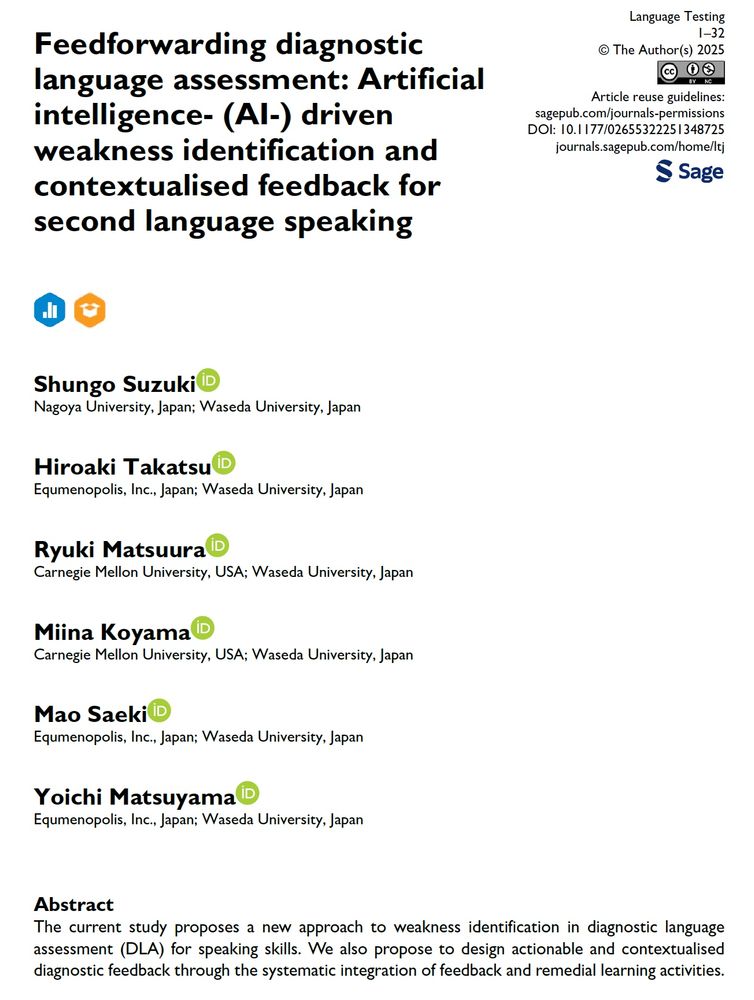
Now available in OnlineFirst, Shungo Suzuki and colleagues propose a new approach to weakness identification for L2 speaking skills in diagnostic language assessment (DLA), with an AI-driven DLA program that uses contextualized diagnostic feedback to improve lexical use. doi.org/10.1177/0265...
05.08.2025 03:38 — 👍 1 🔁 1 💬 0 📌 0
At this point, I might as well --
Here's an infographic showing different ways to include age as a predictor. The top shows two extremes, just as a plain old numerical predictor (imposes linear trajectory) vs. categorical predictor (imposes nothing whatsoever). And then three solutions in between!
16.07.2025 12:33 — 👍 211 🔁 47 💬 22 📌 1
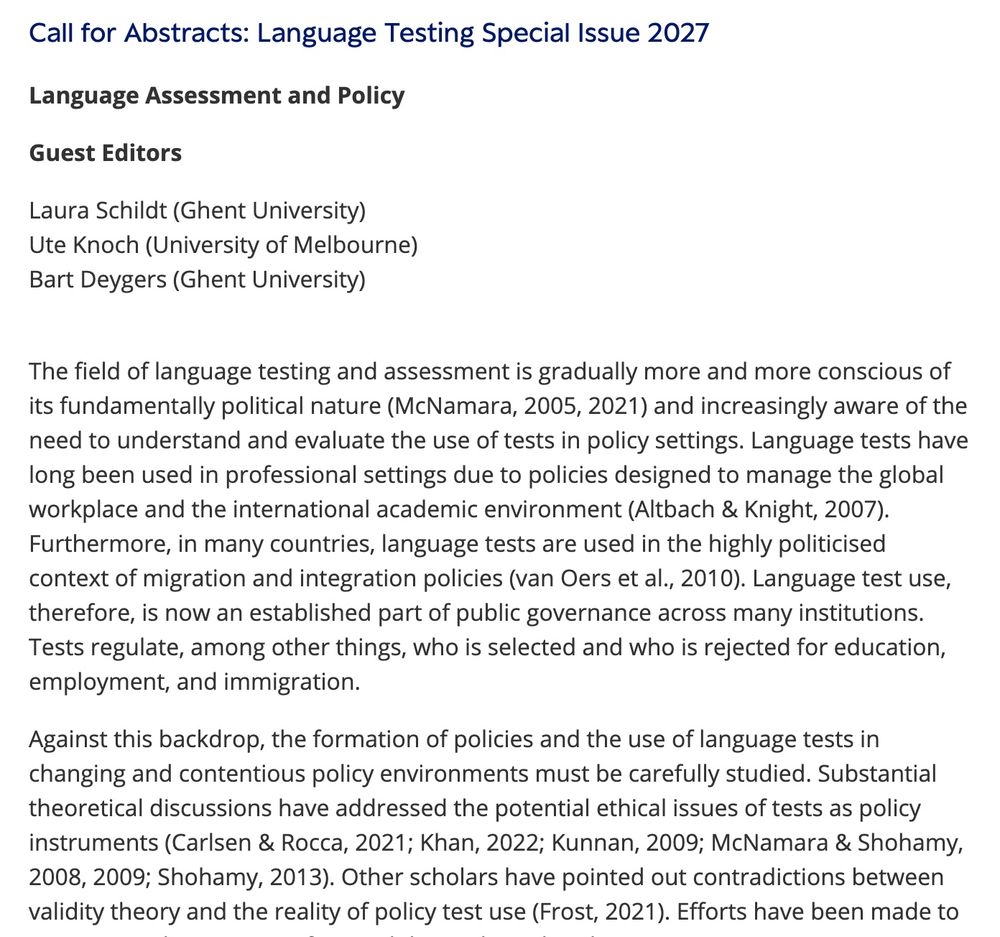
Call for Special Issue abstracts is now open! The Language Testing Special Issue theme of 2027 is “Language Assessment and Policy”. Abstract submission deadline: October 1, 2025. journals.sagepub.com/page/ltj/spe...
08.07.2025 20:57 — 👍 2 🔁 3 💬 0 📌 1
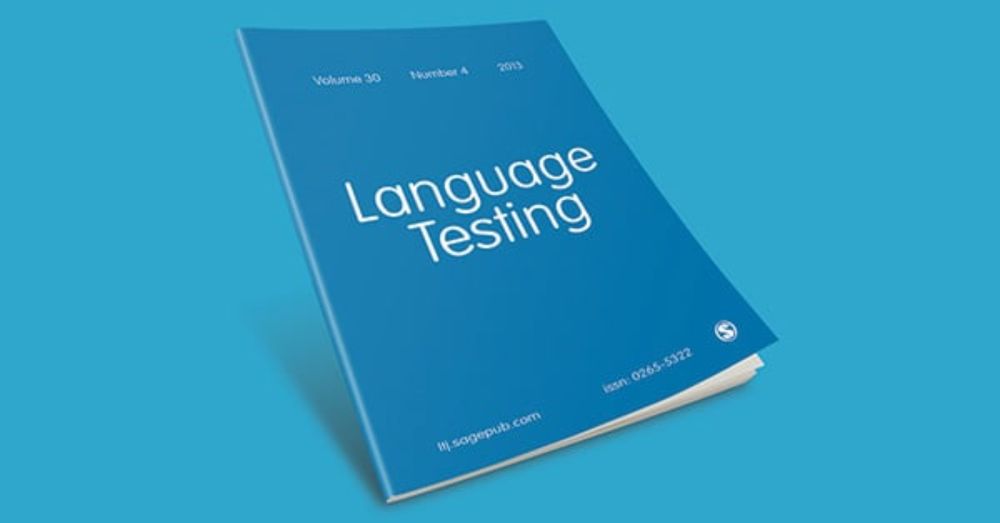
A survey of English language proficiency tests in international student admissions at US research-intensive universities - Nicholas Coney, Daniel R. Isbell, 2025
Over one million international students are enrolled in US higher education institutions. To be admitted into one of these degree-granting institutions, interna...
Our study of English proficiency tests in US R1 university admissions circa late 2023 has been published in #LanguageTesting. Some highlights:
- TOEFL, IELTS, DET, PTE are most widely used
- Most institutions accept around 5 different tests
- Some mismatches in cut scores across tests
...
08.07.2025 23:46 — 👍 5 🔁 1 💬 1 📌 0
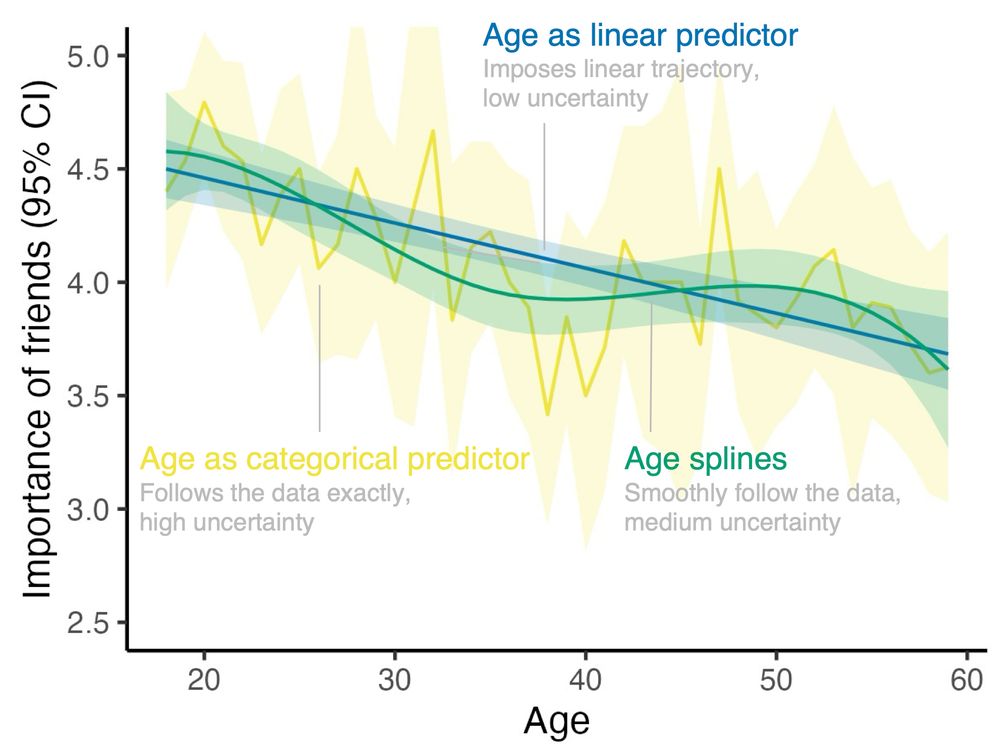
Plot that depicts the average importance people in my data assign to their friendships (y-axis, on a scale from 1 to 5, depicted with 95% confidence intervals) by their age (x-axis, from 18 to 60).
Depicted are 3 different ways to model importance of friends as a function of age.
Using age as a linear predictor: this imposes a linear trajectory which comes with very tight confidence intervals (i.e., uncertainty is low).
Using age as a categorical predictor: this imposes no trajectory whatsoever but instead simply reproduces the means by age. The confidence intervals are very wide, in particular for those ages not well represented in the data (i.e., uncertainty is high).
Age splines: This results in a smooth trajectory that follows some of the bumps in the data, but not all of them. The confidence intervals are somewhere between the linear and the categorical case (i.e., uncertainty is medium)
Let's say you want to include age as a predictor in your model. How do you do that?
Here's an illustration of three options -- it's for a paper I'm working on (so if you feel like anything could be tweaked...).
08.07.2025 12:03 — 👍 160 🔁 31 💬 33 📌 2
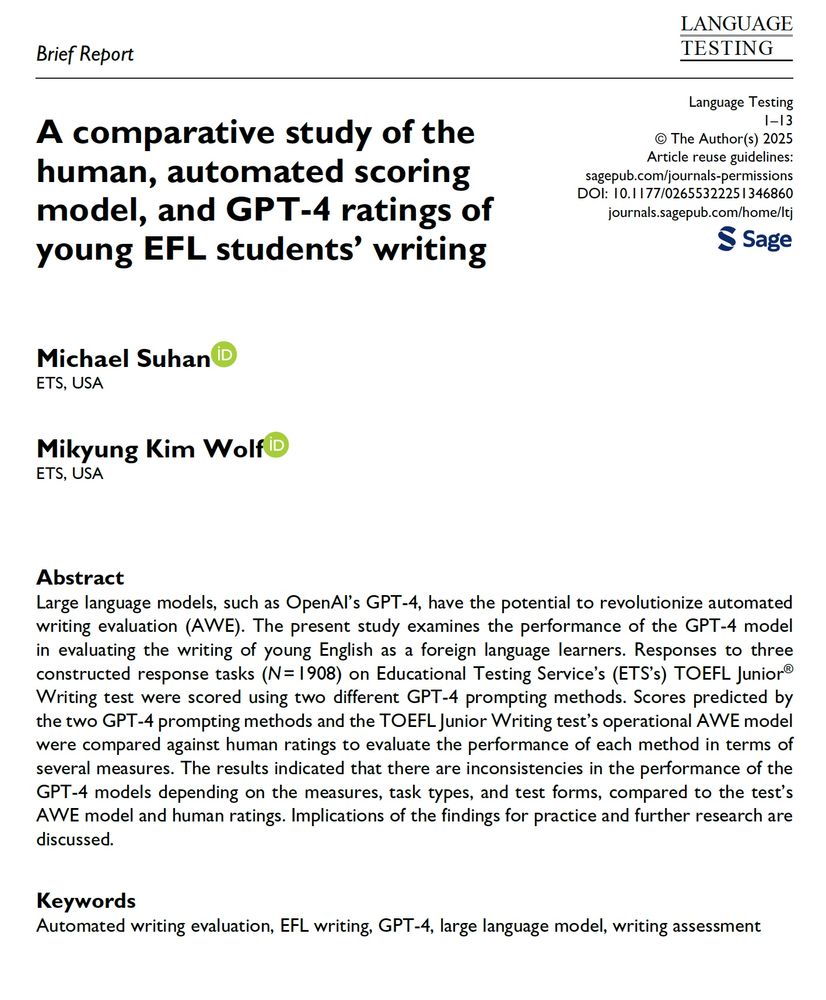
Now available in Online First, Michael Suhan and Mikyung Kim Wolf compare the performance of GPT-4, human ratings, and an existing automated writing evaluation model in scoring the writing responses of young EFL learners on the TOEFL Junior Writing rest.
journals.sagepub.com/doi/10.1177/...
01.07.2025 01:31 — 👍 3 🔁 2 💬 0 📌 0
![What can be learned when multiple analysts arrive at different estimates
Kowall et al. (2025) have brought the multi-analyst approach to epidemiology, with instructive results. With this approach, multiple researchers analyze the same data set to answer the same research question. Or, at least, what appears to be the same research question. In fact, the very first paper that popularized this approach [1] has been criticized for using a vague research question (“Are soccer referees more likely to give red cards to players with dark skin tone than light skin tone?”), which apparently led the analysts to try to answer quite different questions—from a simple question about a bivariate statistical association to much more complex causal questions about racial bias [2].
In contrast, the research question passed on to analysts in Kowall et al. (2025) seems less ambiguous: Does marital status influence the incidence of cardiovascular disease? But less ambiguous does not equal unambiguous. Considerable...](https://cdn.bsky.app/img/feed_thumbnail/plain/did:plc:gz53felr7btxgmbxae5aooxi/bafkreidvs4c7wvoh63tr2ptmvnnl5hya246ofttwyzlvotkmqhnpwgbf4a@jpeg)
What can be learned when multiple analysts arrive at different estimates
Kowall et al. (2025) have brought the multi-analyst approach to epidemiology, with instructive results. With this approach, multiple researchers analyze the same data set to answer the same research question. Or, at least, what appears to be the same research question. In fact, the very first paper that popularized this approach [1] has been criticized for using a vague research question (“Are soccer referees more likely to give red cards to players with dark skin tone than light skin tone?”), which apparently led the analysts to try to answer quite different questions—from a simple question about a bivariate statistical association to much more complex causal questions about racial bias [2].
In contrast, the research question passed on to analysts in Kowall et al. (2025) seems less ambiguous: Does marital status influence the incidence of cardiovascular disease? But less ambiguous does not equal unambiguous. Considerable...
Kowall et al. published a multi-analyst epi study on the effect of marital status on cardiovascular disease (link.springer.com/article/10.1...). What can be learned from this effort? Check out our new commentary! link.springer.com/article/10.1...
with @mendelrandom.bsky.social & Marcus Munafò
30.05.2025 05:56 — 👍 101 🔁 31 💬 5 📌 9

Waking up in Salzburg ready for the kickoff of #EALTA2025! Karen Dunn and I are starting our workshop today on modeling clustered and repeated language assessment data in R.
26.05.2025 05:23 — 👍 5 🔁 0 💬 0 📌 0
Congratulations! 🎉🎉🎉
25.05.2025 08:25 — 👍 2 🔁 0 💬 0 📌 0

Grad Programs
This page serves as a directory of graduate-level programs in applied linguistics. Its main purpose is to help prospective students find PhD/EdD programs that might match their scholarly interests as ...
Luke Plonsky has put together a directory of Applied Linguistics graduate programs in the US (in progress! get in touch if you have any others to add) over at Applied Linguistics Press. Great resource for prospective grad students and those interested in taking stock of the field.
19.05.2025 19:19 — 👍 7 🔁 2 💬 0 📌 0
Thanks to everybody who chimed in!
I arrived at the conclusion that (1) there's a lot of interesting stuff about interactions and (2) the figure I was looking for does not exist.
So, I made it myself! Here's a simple illustration of how to control for confounding in interactions:>
11.05.2025 05:34 — 👍 1135 🔁 275 💬 69 📌 18
The deadline for ECOLT proposals has been extended to April 27th! We look forward to seeing you at Georgetown University in September.
14.04.2025 20:13 — 👍 0 🔁 1 💬 0 📌 0
The deadline for ECOLT proposals has been extended to April 27th! We look forward to seeing you at Georgetown University in September.
14.04.2025 20:13 — 👍 0 🔁 1 💬 0 📌 0

ECOLT - Call for Proposals
The ECOLT 2025 Call for Proposals is now open
Submit here today!
Remember to submit your proposals for the East Coast Organization of Language Testers conference, which will be held at Georgetown University on September 26, 2025! The deadline is April 20th.
sites.google.com/view/ecolt/e...
01.04.2025 12:13 — 👍 0 🔁 0 💬 0 📌 1
Also, I will be speaking with Nivja de Jong and @jvbanerjee.bsky.social at the Assessing Speaking SIG about Listening as part of the construct of Speaking. Come join us!
ealta-annual-conference.org/wp-content/u...
29.03.2025 17:50 — 👍 2 🔁 1 💬 0 📌 0
Registration - EALTA Annual Conference
Join Karen Dunn and me for a pre-conference workshop at EALTA (in beautiful Salzburg!) where we will discuss linear mixed-models and generalized linear mixed models for the analysis of language testing data. ealta-annual-conference.org/registration/
29.03.2025 17:50 — 👍 4 🔁 1 💬 1 📌 0
I asked DeepSeek to develop a scale to measure addiction to addiction scale development and of course it delivered.
25.03.2025 14:34 — 👍 167 🔁 47 💬 18 📌 9
We undertake fundamental research into the psychological, social and biological foundations of #language | Onderzoeksinstituut voor #taal, van genetica tot gedrag |
Open-access, peer-reviewed journal dedicated to publishing research on language, language use, language acquisition, language teaching, and language assessment. https://tesolal.columbia.edu
Assistant Professor @HKUniversity. PhD Applied Linguistics @unimelb. Research linguistic landscape, multilingualism, migrant communities
Ph.D candidate @mpi-nl.bsky.social studying multimodal alignment in social interaction. Interested in #mulitmodality, #interaction, #kinematics, #stats, #causal_inference. Okinawa🇯🇵 → Nijmegen🇳🇱
Director,Max Planck Institute for Psycholinguistics; Multimodal Language Dept.Turkish expat studied in the US; lives @Netherlands,works for the German Max Planck Society - aspires to be a diverse woman leader https://www.mpi.nl/people/ozyurek-asli
Where to eat and why it matters in the world's best food cities.
From Spain. Based in São Paulo 🇧🇷
Food, travel, tech, life, Brazil.
ES/ ENG / PT-BR
Artista de los que hace cosas en video.
Cartagenero Barcelonés
www.fitoconesa.com
@fito_conesa
Professor of applied linguistics at Georgia State University, corpus researcher, pattern fan, yogi, University of Cologne and University of Hanover alumna
Prof/Dean @ AnadoluUniversity + DistanceEducation + LeisureLearner, dreamer + Ed/AEd: AJDE, Open Praxis, HERD, Online Learning, eLearn, CAEE #GO_GN #COER
Academic books, journals and news from the Linguistics department at De Gruyter Brill @degruyterbrill.bsky.social, including its imprint Mouton. Posts by our editors.
Dr. phil. Postdoc in foreign language teaching and learning. Interested in language (teacher) education, teacher individual characteristics, language aptitude, language testing and assessment, educational assessment and feedback.
Assistant prof at University of Amsterdam using motion tracking and virtual agents to study multimodal language and social interaction.
Autistic and interested in autistic language and interaction.
Dad/papa, artist, runner, gamer.
Language Testing is a fully peer reviewed international journal that publishes original research and review articles on language testing and assessment.
journals.sagepub.com/home/ltj
Research | AI in Language Teaching & Learning | Second Language & Multilingual Education | Language Assessment | Early Childhood Education
Applied linguist. Language educator. “This place could be beautiful, right? You could make this place beautiful.” 💙💖💜
The latest research in Language and Linguistics from @universitypress.cambridge.org
cambridge.org/linguistics
Applied linguist at Australian National University working on language use and language assessment in health, education & migration
Grup de Recerca en Adquisició de Llengües / Language Acquisition Research Group based in Barcelona, Spain










![What can be learned when multiple analysts arrive at different estimates
Kowall et al. (2025) have brought the multi-analyst approach to epidemiology, with instructive results. With this approach, multiple researchers analyze the same data set to answer the same research question. Or, at least, what appears to be the same research question. In fact, the very first paper that popularized this approach [1] has been criticized for using a vague research question (“Are soccer referees more likely to give red cards to players with dark skin tone than light skin tone?”), which apparently led the analysts to try to answer quite different questions—from a simple question about a bivariate statistical association to much more complex causal questions about racial bias [2].
In contrast, the research question passed on to analysts in Kowall et al. (2025) seems less ambiguous: Does marital status influence the incidence of cardiovascular disease? But less ambiguous does not equal unambiguous. Considerable...](https://cdn.bsky.app/img/feed_thumbnail/plain/did:plc:gz53felr7btxgmbxae5aooxi/bafkreidvs4c7wvoh63tr2ptmvnnl5hya246ofttwyzlvotkmqhnpwgbf4a@jpeg)



